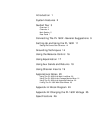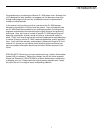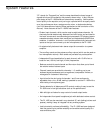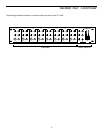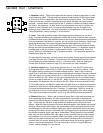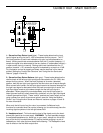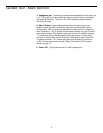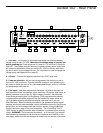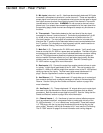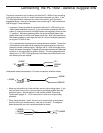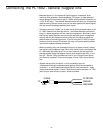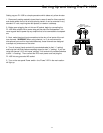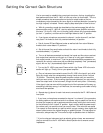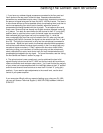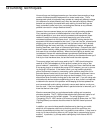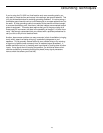
8
Guided Tour - Rear Panel
5: Mic inputs (channels 1 and 3) - Use these electronically balanced XLR jacks
to connect a microphone to channels 1 and/or channel 3. These are intended to
accept signal from low-level, low-impedance mics but can also be used for signal
from other sources (such as direct injection boxes) if the channel’s Trim control
(see #6 below) is turned down.
WARNING: Do not connect a channel’s micro-
phone input if you already have something connected to its line input (see #4 on
the preceding page); these channels are designed to accept only one source or
the other.
6: Trim controls - These knobs determine the input level of the mic signal
connected to channel 1 and/or channel 3. Continuously adjustable from +4 dB
to -40 dB, a trim control is at unity gain (no boost or cut) when set to the “0”
(9 o’clock) position. The input signal is boosted when the trim is turned clock-
wise from the “0” position and is attenuated when turned counterclockwise from
the “0” position. For information on how to properly set this, see the section on
page 12 entitled “Setting The Correct Gain Structure.”
7: Main Out (L, R) - These are the PL 1602’s main outputs. You’ll usually use
these to connect the PL 1602 to a power amp and speakers. The Main out jacks
are electronically balanced, so you should use balanced three-conductor cabling
and 1/4" TRS plugs wherever possible (unbalanced two-conductor plugs can
also be inserted into these outputs, but you’ll get better signal quality and less
outside noise and hum if you use balanced lines). See the “Connecting the
PL 1602” section on page 9 for more information.
8: Bus Inserts (L,R) - Connect the output from another device to these in order
to “submix” in their signal (post-fader) to the PL 1602. This can be used to link
multiple PL 1602s or to add the output from another mixer to the PL 1602 without
taking up channel line inputs. The Bus Insert jacks accept unbalanced 1/4"
plugs. See the “Applications” section on page 20 for more information.
9: Aux Returns (1, 2) - These unbalanced 1/4" inputs allow you to route signal
from external devices such as effects processors to either of the two stereo Aux
Returns. See the “Using the Aux Sends and Returns” section on page 18 for
more information.
10: Aux Sends (1, 2) - These unbalanced 1/4" outputs allow you to route signal
from each of the two discrete Aux Sends to external devices such as effects
processors. Both Aux sends are pre-fade but post-EQ. See the “Using the Aux
Sends and Returns” section on page 18 for more information.
11: Channel Inserts (1 - 6) - Use these to insert an external effects processor
(such as outboard equalizer, compressor/limiter or noise gate) into any of the
PL 1602’s channels 1 - 6 in an “effects loop” configuration. These jacks accept
1/4" TRS plugs, with the ring carrying the send signal and the tip carrying the
return signal. Normally, this will be connected to a Y-cord; see the “Connecting
The PL 1602” section on page 9 for more information and a wiring diagram.



